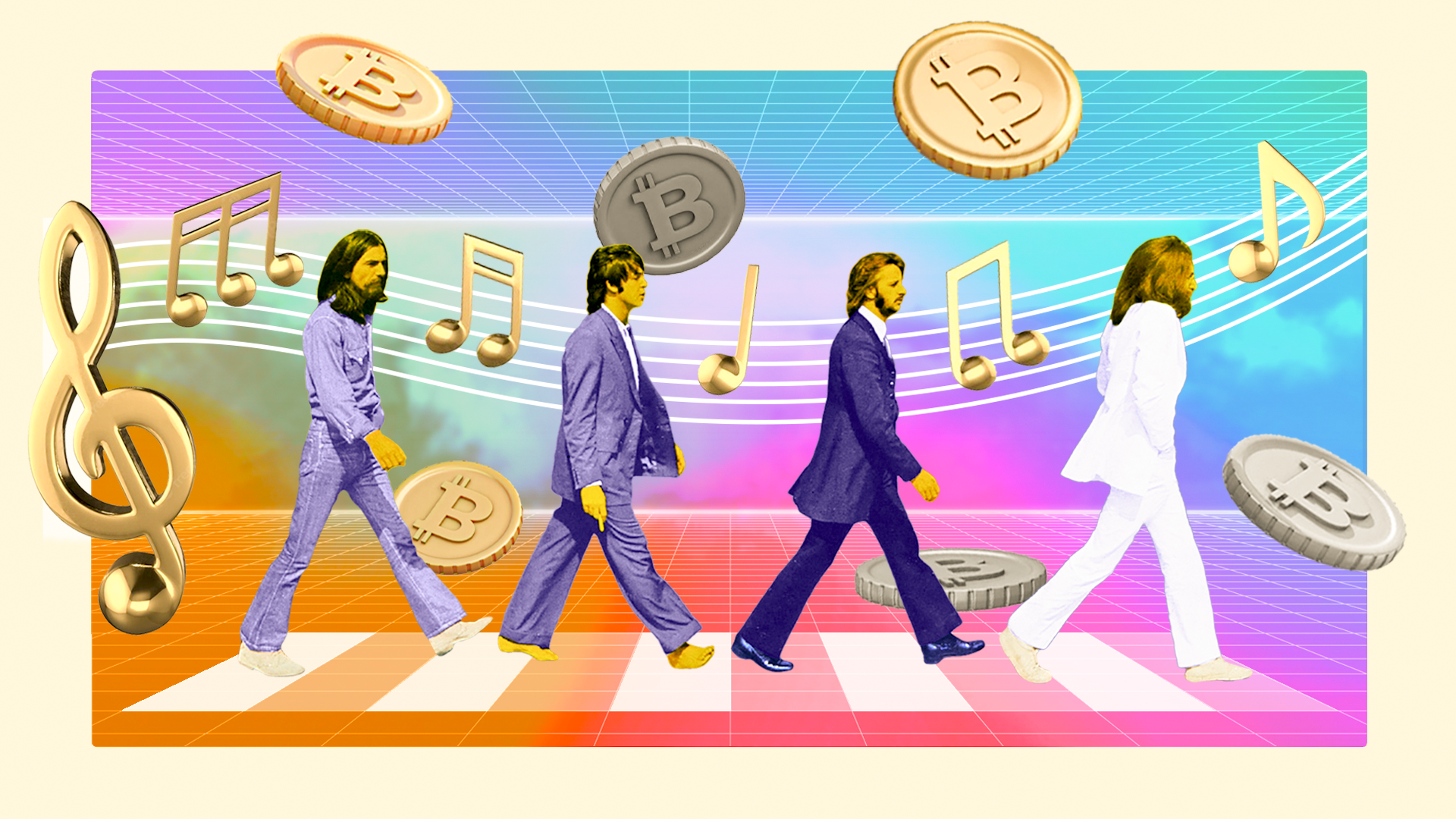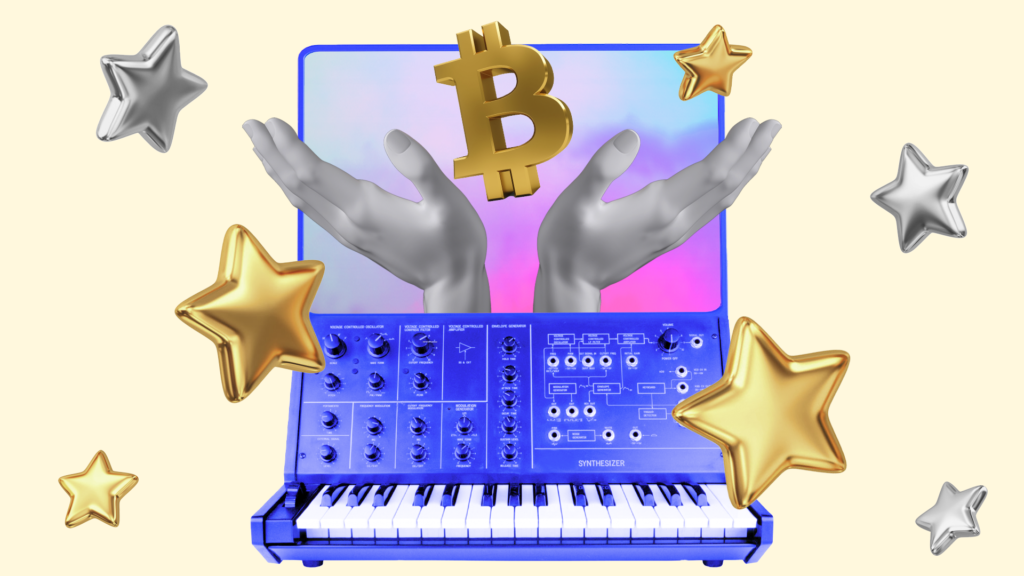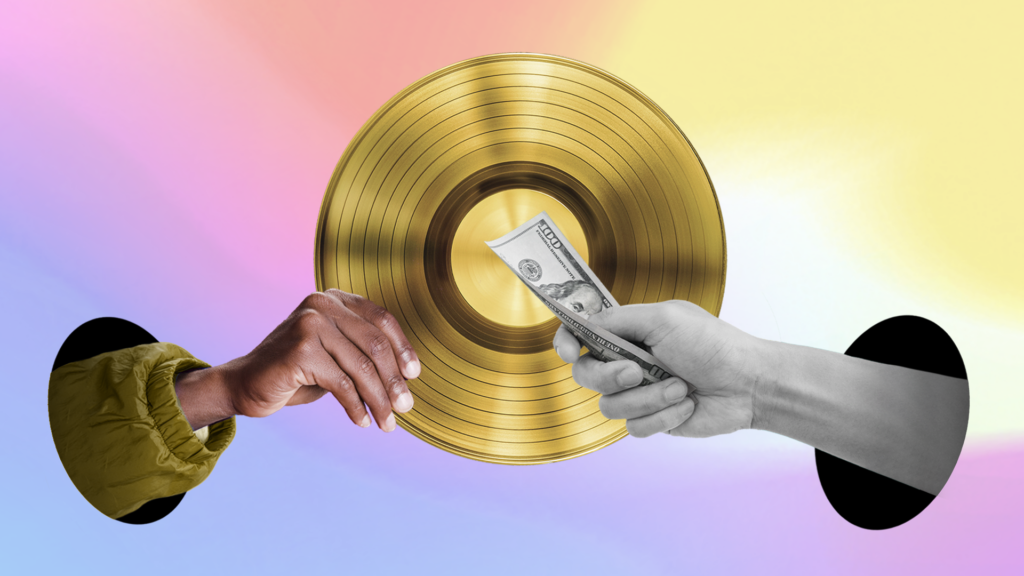

The history of modern show business knows many stories of worldwide popularity bringing attention, glory, money and problems at the same time. A similar case happened to legendary Beatles musicians, John Lennon and Paul McCartney, when they lost the rights to their own songs nine years after the band was formed. It wasn’t until 48 years later, in 2017, when McCartney finally reached a settlement with Sony/ATV over the copyright to the Beatles catalog. The details of their agreement, however, have not been disclosed. Besides legal issues within the band, The Beatles were also implicated in copyright lawsuits with other artists. These complicated court cases, where the melody, rhythm, or words of one musician are reused in the songs of another, are actually quite common. The decisions of these trials can differ drastically, and no one can be sure of their outcomes when filing a claim.
NFTs (non-fungible tokens) can shed some light on the unclear phenomenon of music copyrights. Blockchain technology can regulate the ownership of art and has clear advantages over the traditional understanding of copyrights.
NFTs are widely used in the metaverse, which we discussed in our project “Theta in Meta”. They serve to set copyrights on the pieces of art, land plots, pieces of clothes and much more. Some artists are convinced that music fosters an emotional connection with the listener. It’s the fans who make a song popular, but they don’t receive any value beyond the emotional connection. If a musician could share their royalties with supporters then they would make that relationship even stronger, and fans would have a financial incentive to stream and promote that song even more.
Besides the problem concerning the unclear approach to music copyrights, there are also issues with unfair royalty payments to musicians. This is owing to the thick layer of intermediaries between an artist and its fans and which makes it almost impossible for an ordinary person to invest in the music industry. NFTs are our chance to change the current music business model and enter a new era where artists can become independent, and fans can earn along with their favorite bands. But what are these mysterious NFTs and can they be bought in local music stores right now? During the next chapters, we explain their principles and benefits in simple phrases. Let’s dive in.

The breaking NFT technology is changing the way we own things digitally. But what exactly is a non-fungible token (NFT)? First, let’s take a look at the word “fungibility.” Fungible items are exchangeable 1:1 with an item of the same description or classification. Each fungible unit is considered identical and therefore interchangeable. The slight physical differences between fungible assets do not impact their perceived or agreed value.
The concept of fungibility is easily explained through the understanding of currency. A crisp ten-dollar bill, a ten-dollar bill found inside the pocket of your old jacket, or a ten-dollar bill with somebody’s phone number scrawled on one side are each worth 10USD. With any of these bills, you can pay for a nice cup of coffee for $5 and receive $5 back. Therefore, fungible assets are also divisible.
On the contrary, things that are not directly interchangeable or replaceable are known as non-fungible. Non-fungible units are unique, and their identity is verifiable. In many ways, non-fungibility is tied closely to identity, be it the identity of the asset itself, its owner, or its creator.
If after long hours in the shopping mall a family found themselves standing in the center of the parking lot unable to recall where the car is, they can’t simply take any other car of the same model as theirs. Every same-looking car in this huge parking space is unique. It might be of the same characteristics and even cost the same, but each vehicle has its own history, scratches, and items inside. It’s only the owner of this precise car that can decide who has access to their property.
At the very beginning, blockchain was all about cryptocurrency. How the blockchain technologies are used today, we’ve covered in our project about Web3. Follow the link to discover more about the future development of the internet. But then some forward-thinking developers realized that this technology could be used to create and store unique, identifiable digital items, digital representations of real-world objects such as diplomas and marriage certificates, and so much more.
Thus, the NFT was born.
An NFT provides a solution essentially anywhere uniqueness or identity plays an important role, whether it’s for art, gaming items, commemorative collectibles, digital rewards, or anything in between.

For so long, if you wanted to invest in music you needed to fork over millions of dollars to purchase an artist’s catalog in order to reap the rewards and get paid every time a song is played. Today, blockchain technologies open up a new way to invest in the music industry.
As we’ve already mentioned, currently most people acquire NFTs not to profit but to support a favorite artist or to feel the ownership of a legendary item. If you want to buy an NFT as a lucrative investment, it’s important to find a product that you can purchase in the usual way, by going to one of the platforms selling NFTs (beware of scammers), choosing a digital asset, and paying with a cryptocurrency accepted by the service.
Discover the limitless possibilities of Web3 technology with Whatdahack?!. Our team specializes in delivering Web 3.0 platform development tailored to your vision – offering expertise in creating dApps, DAOs, and smart contracts, as well as building crypto wallets, DeFi protocols, DEX platforms, and state-of-the-art NFT marketplaces. Looking to explore GameFi, integrate Web 3.0 solutions into your existing ecosystem, or design captivating experiences with 3D design and animation? We transform your ideas into reality with comprehensive design, development, and Web 3.0 integration services. Start your journey today by visiting our Web3 Development page.
The last thing to consider before sharing royalties with celebrities are the current issues with blockchain technology.
The most common concern is that it’s still possible to stream online for free. As with books, one of the earliest editions of The Lord of the Rings is currently being sold for $173,527.60 (January 27, 2025)! Meanwhile, you can purchase the same book from the local charity shop for a dollar.
Same with the NBA top shots. These videos might be easily watched on YouTube, but it’s more about the feeling of ownership. It’s the verified original file.
While NFTs have the potential to hand back power to the artists, right now there are no clear boundaries as to who owns the intellectual property of a song if it was to be issued as an NFT. The NFT owner will still receive royalties but as of this moment it’s unknown whether we’re also handing over the master rights along with the master file? What is known is that record labels will want to fully monetize their artists and this could lead to future legal battles that could slow the development of music NFTs. It remains to be seen how much power will be restored to an artist who’s already been signed.
However, once the systems are in place, it could simplify some gray areas. Currently, licensing music or transferring ownership is an inconvenient process for labels and lawyers, and something that has to be done manually. With NFTs, the process is about as quick as buying anything else online, and you’re provided with clear documentation. So, once we have the system set up, everything will be more clear-cut, which could also help to avoid a bunch of lawsuits. In addition, an artist could get paid every time a sample of their music is used in a new song, though unfortunately, it’s going to be a while before we arrive there.
Pricing is another definite concern. Anything with scarcity built into it will go to the highest bidder, which means a huge proportion of the population will not be able to afford some of these NFTs. Part of the responsibility for the availability of NFTs at different price points, allowing for all fans to be involved in the connectivity, will go to the artists, labels and anyone else issuing them.

Still, the reality remains that many of these unique and premium NFTs won’t be available to most of us, and although we’ve talked about the potential to increase connectivity, there’s a side to this that could make social divides even greater.
Moreover, some NFTs will be a bubble. We’re going to see many people trying to harness the potential of NFTs, and they’ll try to sell them for as much as anyone will pay. This means we’ll see huge spikes and the usual big falls as demand drops. As the hype around individual NFT projects grows, we’re going to see people who aren’t even music fans trade in and out of the latest music trend or NFT before moving on to the next big thing. This means there’ll be ups and downs that will be difficult to predict.
A large criticism of NFTs, and cryptocurrencies as a whole, is the huge amount of computational power required for them to run. The most popular blockchain for NFTs is Ethereum. Ethereum currently consumes the same amount of energy as the entirety of Peru.
Hopefully, there will be a way around this. Ethereum is planning to switch to Ethereum 2.0, which should cut emissions by 50%. There’s still much work to be done, however, to ensureNFTs don’t cost us
NFTs are changing the music industry and certainly open up some exciting possibilities for artists and their fans. The smart contract has the potential to remove all intermediaries or middlemen in the music business and allow artists to connect with fans more directly.
NFTs can be applied in the film industry as well. A perfect example of a movie to invest in is “Paranormal Activity.” This film was originally developed as an independent feature for $15,000 before being acquired by Paramount Pictures. Some changes brought by the company additionally cost $200,000. After it was released in 2009, the earnings exceeded $190 million! Fashion items, sneaker and shoe models, and handbags often become pieces of art which can also be digitalized through blockchain.
The game-changing technologies of today are opening the door to a new era. No-name artists receive a chance to quickly succeed only with the support of their fans. What if the garage band whose concert you visit tomorrow is the future Beatles? What if the studio where last week you bought your nice jacket will soon become the Fashion House of global renown? NFTs are the next stage of human and economic development that invites everybody to participate and find their place in this game.
Illustrator – Maryana (tg: @maryana_chelovek)
Copywriter – Kirill (tg: @MysteriousLeo)
Editor – Damo Jackson
Project Coordinator – Artem Kopylskiy
Producer – Roman Gorbunov